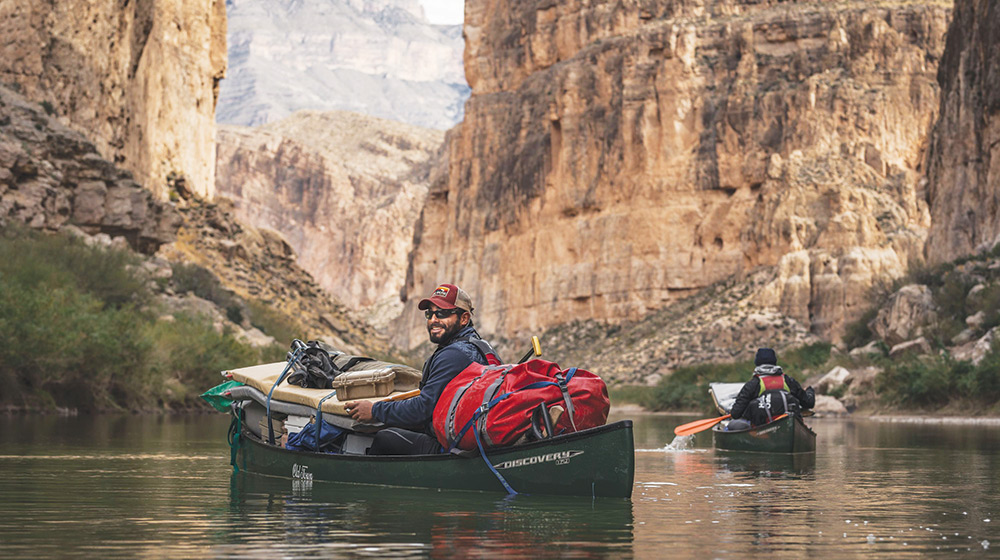The lunatic proposal to wall off America’s southern border from sea to sea is a waste of both time and treasure.
The implications of this partisan folly look even worse after watching Ben Master’s The River and the Wall. It documents a 1,900 mile journey from the shoulder of Texas to its toe down at the Gulf of Mexico. Five travellers follow the Rio Grande, America’s fourth largest river. It’s just one front for this proposed ‘big, beautiful wall.’
According to this gloriously photographed study, only 3 percent of Texas is publicly owned. Most of that is in Texas’s Outback, the Big Bend region. It is titanic country, 800,000 acres of open land. It’s remote, often tractless, a place to stir the soul of anyone who loves a western movie. The area is so rugged that it has to be seen just so that the wall can be laughed off properly: vertical cliffs facing each other hundreds of feet above the river, mesas, box canyons and bluffs. Says Masters, it’s ”like the Grand Canyon without the crowds.”
The five-person adventure is carried out on mountain bike, on mustang back and in canoes. The trip includes a surprise snowfall that turns the road to mud, and a passage downstream through the rapids. Director Masters travels with ecologist Jay Kleberg, river guide Austin Alvarado, photographer Filipe DeAndrade and a Coachella-beanie-wearing, Cornell-trained ornithologist named Heather Mackey. She’s there to observe the subtropical bird and butterfly haven at Bentsen Rio Grande Valley State Park. See it now, if you can; this habitat may well soon be scraped by bulldozers and divided by the wall to be.
Part of the incalculable price of the wall is the closure of wildlife corridors over the border, even after the creatures there had started to come back from extirpation—bears, bighorn sheep and pronghorns, among others. A 2006 law lets the government ignore environmental issues when seizing land for border security. Some potential victims in the deep south of Texas are farmers who may lose access to the Rio Grande water, as well as rich fields, arable year-round. Farmland might be ceded to Mexico just because it’s easier to build a wall on a levee than on a riverbank.
The travellers do face potential danger, in the south near Brownsville. Boating by night, as they were advised not to do, they encounter a party of illegal crossers. They might be ordinary mojados or they might be dangerous narco traffickers, on the job satisfying the U.S.A.’s sweet tooth for drugs.
In America, we have an estimated 11 million undocumented residents, most of them here on overstayed visas. Over the decades, the matter has been a source for sidestepping bipartisan twaddle: seen here, presidents Trump, Obama, Clinton and George W. Bush’s exact wording differs, but what they said comes down to the same empty phrase: “We’re a county of immigrants, but we’re also a country of laws.”
University of Texas at Austin scholar Victoria deFrancesco Soto, interviewed here, argues that “folks don’t choose to be undocumented. When people say ‘get in line,” many times the line doesn’t exist.” Democratic Texas Congressman Beto O’Rourke and Republican Will Hurd here agree that the wall is, as Hurd puts it, “the most expensive and least effective way to do border security.”
The River and the Wall sometimes goes in for homemade YouTube travel documentary–style whimsy. At one point Masters cuts away from something interesting Hurd was saying just to show DeAndrade clowning around about his saddle-soreness as a novice horse rider. Masters has a point, though. Two of these travellers, DeAndrade and Alvarado, were once illegal immigrants. DeAndrade, an irrepressible guy with a pierced lower lip, is now an award-winning photographer for National Geographic. Both men are evidence not of what we’re losing by having immigrants, but what we’re gaining.
It’s unclear whether factors such as beauty, remoteness, or common sense will save a wilderness that makes the heart soar to look upon it. One proposal is combining Big Bend National Park with the Mexican nature reserves on the far side of the Rio, similar to Waterton Glacier International Peace Park on the Canada-U.S. border. The River and the Wall displays such majesty that one understands how words fail the likable travellers: ”Isn’t nature neat?” one exclaims.








